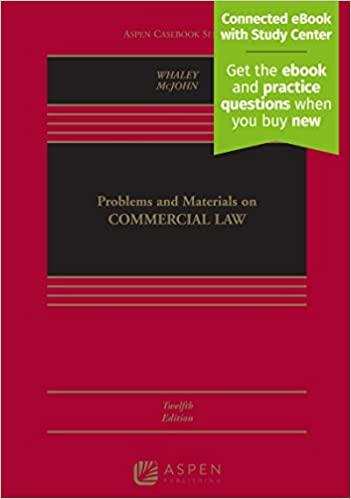Question
Business law question number 345 Case study: 1. Raw materials inventory includes direct material costs associated with purchasing raw materials in order to manufacture the
Business law question number 345
Case study: 1. Raw materials inventory includes direct material costs associated with purchasing raw materials in order to manufacture the product as well as freight-in costs related to acquiring the materials. Materials could include things such as wood or plastic that are directly involved in production of the product. The work-in-process inventory also includes direct materials costs, and also includes direct labor costs and overhead incurred during the period. Direct labor costs include not only wages accrued by workers, but also employee benefits; overhead includes overtime and supervisor salaries earned during the period. The finished goods inventory includes all costs from the work-in-process inventory that have been completed during the period. 2. Inventories are recorded net of unmarketable or obsolete inventory. This allowance is based on current inventory levels, past sales trends, and historical data in addition to management's estimates on market conditions and predictions for future market conditions and product demand. All of these things are subject to change, and therefore management must make proper and conservative estimates in order to have a correct estimate of inventory, which should be approximately equal to the fair value of the inventory. 3. a. This amount for unmarketable or obsolete inventory does not appear as a line item within the financial statements. This amount may be disclosed in the notes to the financial statements, but without such a note, it does not appear on the financial statements. b. Gross inventories 2011 - $243,870 Inventory amount on the balance sheet for 2011 - $233,070 Balance in allowance account at year-end 2011 - $10,800 27 Gross inventories 2012 - $199,214 Inventory amount on the balance sheet for 2012 - $211,734 Balance in allowance account at year-end 2012 - $12,520 c. The allowance for obsolete and unmarketable inventory would be attributed to the finished goods and raw materials inventories. The portions attributable to each type of inventory would be based on the proportion of total inventory that each type makes up. Obsolete inventory, by nature, could not be attributed to work-in-process inventory because the units would have to be finished or not yet begun to be considered unmarketable; for example, a portion of raw materials could be considered obsolete if some amount of raw materials was unused at the end of the period. 4. 2012 Cost of goods sold 13,348 Allowance for obsolete and unmarketable inventory 13,348 Allowance for obsolete and unmarketable inventory 11,628 Finished goods inventory 11,628 28 5. a. $572,549 is the cost of finished goods sold. b. $568,735 is the cost of finished goods transferred from work-in-process. c. $442,068 is the cost of raw materials transferred from work-in-process. d. $438,561 is the amount of raw materials purchased. e. $432,197 is the amount of cash disbursed for raw materials. 6. 2011 Inventory Turnover ratio = $575,226/(($211,734+233,070)/2) =2.6344 times 2012 Inventory Turnover ratio = $585,897/(($233,070+268,591)/2) =2.2933 times 7. 2011 Inventory Holding Period = 365/2.6344 =138.55 days 2012 Inventory Holding Period = 365/2.2933 =159.16 days On average during 2011, the company is holding inventory for 139 days before it is sold. In 2012, the company holds its inventory for 159 days before it is sold. From 2011 to 2012, the company is slightly less efficient in its in inventory management. 8. Percent of finished goods estimated as obsolete = 13,348/(167,646+13,348) =0.0737, or 7.37% of finished goods are considered obsolete in the current year. This is the Raw materials inventory Work-in-process inventory Finished goods inventory, net $46,976 $1,286 $184,808 $438,561 $568,735 $13,348 $442,068 $126,000 $572,549 $43,469 $442,068 $568,735 $619 $167,646 Cost of sales Accounts payable $- $39,012 $13,348 $438,561 $572,549 $432,197 $585,897 $45,376 29 provision for obsolete inventory divided by gross finished goods inventory, which is the net finished goods inventory plus the provision. As an investor, I would like to know more information regarding prior years in order to determine whether or not the company is improving this ratio. It might also be helpful to know what type of product this company is making so that this percentage and other ratios may be compared to other industry companies.
Question 8
1. Which of the subsequent distinguishing can happen both in __________picture-perfect opposition and in monopoly____________
2. A factory owner or a corporation should agree to take reserves that offer charges of return _____ their occasion costs of investment.
3. When price intensifications, the measure wanted commonly tends to reduction for the reason that of:
I.income effect
II.substitution effect
4. Uncertainty there are vicissitudes in factors other than a produce's own price that disturb the quantity acquired, the singularities is dubbed as
5. An increase in supply generally _____ price and _____ quantity demanded.
6. Marginal revenue (MR) is _____ when demand is elastic, _____ when demand is unit-elastic, and _____ when demand is inelastic.
7. The incidence and the influence ______of the sales taxes which are made is ________
8. The greatest indirect taxes revenue ______which are being collected can be made by__________
9. The bucket which consist of the major significance __________-currencies is named as ________
10. The direct exchange of services and goods for the another goods and services can also be termed as ______________
Step by Step Solution
There are 3 Steps involved in it
Step: 1

Get Instant Access to Expert-Tailored Solutions
See step-by-step solutions with expert insights and AI powered tools for academic success
Step: 2

Step: 3

Ace Your Homework with AI
Get the answers you need in no time with our AI-driven, step-by-step assistance
Get Started


